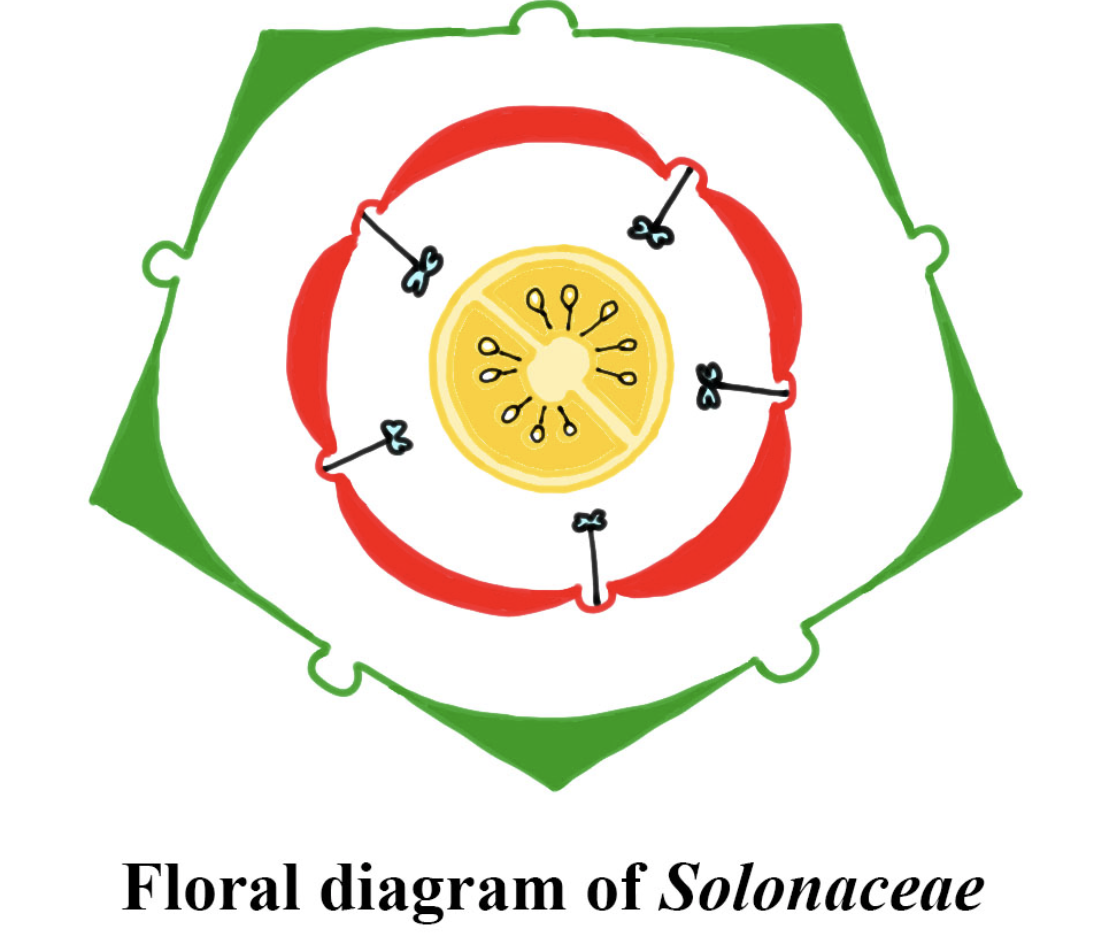
Oblique ovary is found in
(a) Liliaceae
(b) Liliaceae
(c) Solanaceae
(d) Asteraceae
Answer
477k+ views
1 likes
Hint: Oblique ovary is a characteristic of the family of flowering plants that range from annual and perennial herbs to vines, lianas, epiphytes, shrubs, and trees, crops, medicinal plants, spices, weeds, and ornamentals, etc. Many members of the family contain potent alkaloids, and some are highly toxic, but many including tomatoes, potatoes, eggplant, bell, and chili peppers are used as food.
Complete answer:
In Solanaceae, the arrangement of carpels is peculiar. The posterior carpel is tilted towards the right and the anterior one is tilted to the other end and so the septum occupies an oblique position, whereas, in normal condition, it occupies the horizontal position. So it is often described as an obliquely zygomorphic flower.

The Solanaceae is a fairly large family having about 85 genera. They are mostly shrubs, herbs, or small trees. The inflorescence is cyme or cymose panicle. The flower is bisexual, regular, rarely zygomorphic, hypogynous. The Solanaceae is an economically important family of flowering plants which includes many crops that are used as vegetables. Tobacco is an important plant cultivated for commercial use of tobacco. Leaves are variously used for stimulation and contain nicotine. Poisonous alkaloids are produced from Stramonine.
Additional Information:
- Sepals 5, persistent, become enlarged in fruit. Petals 5, Gamopetalous connate in a rotate, funnel-shaped, or bell-shaped corolla; imbricate sometimes plicate or convolute.
- Stamens 5, alternate with corolla lobes, free epipetalous, anthers with apical porous or longitudinal dehiscence.
- Carpels 2, syncarpous, obliquely placed, ovary 2-chambered, or more.
So, the correct answer is ‘(c) Solanaceae’.
Note:
- Gynoecium is bicarpellary syncarpous. The ovary is superior with a terminal style that ends in a capitate stigma.
- The anatropous ovules are arranged on swollen, Axile placentas of the bilocular ovary that may be rendered tetralocular by the formation of a false septum.
- Dye to the imperfect development of the cross wall in capsicum, the ovary is unilocular in the upper part.
Complete answer:
In Solanaceae, the arrangement of carpels is peculiar. The posterior carpel is tilted towards the right and the anterior one is tilted to the other end and so the septum occupies an oblique position, whereas, in normal condition, it occupies the horizontal position. So it is often described as an obliquely zygomorphic flower.

The Solanaceae is a fairly large family having about 85 genera. They are mostly shrubs, herbs, or small trees. The inflorescence is cyme or cymose panicle. The flower is bisexual, regular, rarely zygomorphic, hypogynous. The Solanaceae is an economically important family of flowering plants which includes many crops that are used as vegetables. Tobacco is an important plant cultivated for commercial use of tobacco. Leaves are variously used for stimulation and contain nicotine. Poisonous alkaloids are produced from Stramonine.
Additional Information:
- Sepals 5, persistent, become enlarged in fruit. Petals 5, Gamopetalous connate in a rotate, funnel-shaped, or bell-shaped corolla; imbricate sometimes plicate or convolute.
- Stamens 5, alternate with corolla lobes, free epipetalous, anthers with apical porous or longitudinal dehiscence.
- Carpels 2, syncarpous, obliquely placed, ovary 2-chambered, or more.
So, the correct answer is ‘(c) Solanaceae’.
Note:
- Gynoecium is bicarpellary syncarpous. The ovary is superior with a terminal style that ends in a capitate stigma.
- The anatropous ovules are arranged on swollen, Axile placentas of the bilocular ovary that may be rendered tetralocular by the formation of a false septum.
- Dye to the imperfect development of the cross wall in capsicum, the ovary is unilocular in the upper part.
Latest Vedantu courses for you
Grade 11 Science PCM | CBSE | SCHOOL | English
CBSE (2025-26)
School Full course for CBSE students
₹41,848 per year
Recently Updated Pages
Master Class 9 General Knowledge: Engaging Questions & Answers for Success

Master Class 9 English: Engaging Questions & Answers for Success

Master Class 9 Science: Engaging Questions & Answers for Success

Master Class 9 Social Science: Engaging Questions & Answers for Success

Master Class 9 Maths: Engaging Questions & Answers for Success

Class 9 Question and Answer - Your Ultimate Solutions Guide

Trending doubts
State and prove Bernoullis theorem class 11 physics CBSE

What are Quantum numbers Explain the quantum number class 11 chemistry CBSE

Write the differences between monocot plants and dicot class 11 biology CBSE

Who built the Grand Trunk Road AChandragupta Maurya class 11 social science CBSE

1 ton equals to A 100 kg B 1000 kg C 10 kg D 10000 class 11 physics CBSE

State the laws of reflection of light




